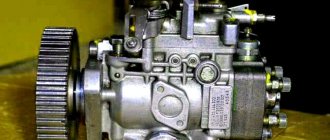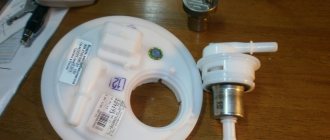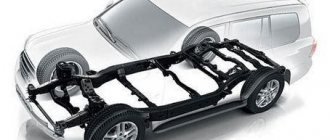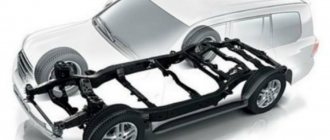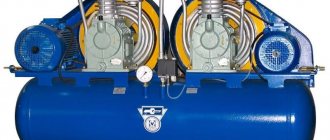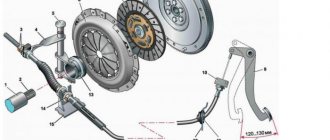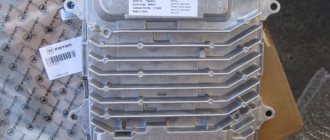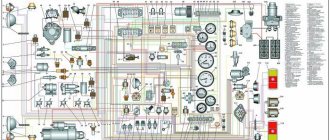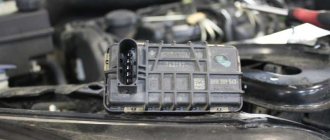The challenges that modern car manufacturers have to solve are quite extensive. Many of them address issues of ecology and power of internal combustion engines. Often they are connected, so complete combustion of fuel gives increased power and improved environmental performance of the engine. If you look more closely at how diesel is used in the design of a car, it turns out that an intercooler helps it cope with the problems raised.
Purpose of the intercooler
So, an intercooler is an additional cooling device that provides cooling of the air masses that come from the supercharger on a turbocharged engine. The design and principle of operation of the intercooler resembles a conventional radiator. Still, we should dwell in more detail on why it is needed.
Car cooling system
There are 2 main functions of cooling devices:
- lowering the temperature values of the injected air;
- reduction in boost pressure.
Temperature drop
An intercooler designed to cool the air flow to ambient temperature could be called one hundred percent effective. But achieving such large values is almost impossible. Therefore, a device that functions at 70% is recognized as the best option. It is this device that is most often used for additional cooling during operation of the power unit.
Decreased pressure
The pressure decrease is caused by the counteraction of air masses created by the intercooler. For its part, this implies some design restrictions, since exceeding the pressure drop by even 1-2 atmospheres is unacceptable. In other words, the device serves to extract thermal energy from air that is heated during compression in the compressor.
The main indicator on which the intercooler developers were based is the greatest removal of thermal energy, the lowest pressure loss during boost and increased inertia of the air flow.
Intercooler diagram
And where to look for it?
If you own a car with a turbo engine, finding an intercooler will be quite easy. Most likely, it is installed frontally, in front of the radiator grille. It is installed in front of the cooling radiator and air conditioner, taking on the main air flow. Or the intercooler is placed under the radiator, in which case the cooling system works more efficiently. Sometimes it can be installed above the engine, and the hood receives a special air intake for cooling. Well, for additional dirt intake, accordingly, such an arrangement will require a little more attention to the cleanliness of the engine compartment.
Diagram of the part and its location in the engine
Externally, the intercooler resembles a radiator consisting of plates and pipes. In order to additionally cool the air, copper or aluminum plates are welded to the tubes.
Externally, the intercooler is not much different from the radiator
In the engine, the part is mounted between the intake manifold and the turbine compressor. It is mounted in the front part of the engine below the radiator, or above the engine. In some car models, the intercooler is located in the wings.
A moment of history
Air intercoolers were used in the design of aircraft, locomotive and ship engines back in the last century, and they had quite large dimensions. The dimensions of the impellers were very noticeable, and their inertia was excessively great. It took a very long time to spin up the impeller shaft, which made it impossible to use turbochargers on car engines with constantly changing speeds during operation - the turbine simply did not have time to react to changing conditions.
A little later, the world learned about lightweight ceramic impellers that could spin quickly, and the problem of inertia faded into the background. Turbines began to penetrate the masses in the 70s, after they began to be actively used in Formula 1. By the way, since then, almost all manufacturers have been trying to have at least one turbocharged car in their model range.
Efficiency of application
Probably, now many have understood what an intercooler is and why an intercooler is needed, but the question remains about its effectiveness. How effective is its use in a car?
Guys, there is some effect. For example, cooling the air by only 10 degrees increases engine performance by about 3%. And as a rule, even “air type” intercoolers cool the air by about 50 degrees, so that’s 15% of the power. But the record holders are water systems; their temperature drop can reach 70 degrees, that is, 21% of the engine power.
As you can see, the installation of this device is very reasonable. However, I would like to immediately note that they are installed only on turbocharged engines, because conventional ones do not have such volumes of air pumped into the cylinders, and they do not have such strong heating.
Types of intercoolers
Now there are only two types of such devices.
1) Air type. Where cooling occurs with the help of air flow when the car moves, the faster the car moves, the more intense the process occurs.
2) Water cooling. As you may have guessed, this happens due to the circulation of coolant.
If we compare these two types, the simplest is the air system, but it is not as effective and is often very cumbersome. Therefore, now many manufacturers are switching to water systems - they are much more compact, and water removes excess temperature much more effectively. However, such systems are more complex in design, installation and subsequent operation.
Types of designs
Currently, the intercooler is used everywhere, on various types of cars. It can be found on both gasoline and diesel cars.
The first and most common type of intercooler is an air-type heat exchanger. It is a kind of battery consisting of tubes connected by plates. Both of them perform the function of heat-removing elements.
On average, this type of intercooler ensures that the air mixture passing through it is cooled to 45-50 degrees. Its presence allows you to increase engine power by 15-20%. The greatest positive effect from the operation of the heat exchanger can be seen when driving at a speed of at least 40 km/h.
Despite all the advantages of the presented device, it also has one rather significant drawback. Due to its functional features, the air-to-air intercooler is very bulky.
In factory conditions, this problem can be solved without much difficulty. It is much more difficult to install this device; there is a need to equip your car with a turbocharger in a garage environment. In this case, there is often a need to make changes to the design of the car body, which entails a lot of inconvenience.
The next type of heat exchanger is usually called water . The working medium in this case is water or refrigerant. Externally, this type of intercooler is strikingly different from the previously presented type.
- Firstly, it is more compact than its air counterpart. It is worth noting that water, unlike air, has a much greater heat capacity. This explains the good heat transfer of this device.
- The second, no less significant advantage is high efficiency.
A comparative analysis of the two systems showed that the water heat exchanger is many times superior to the air heat exchanger in terms of basic performance indicators.
A water intercooler is good for everyone, but it still has one drawback. It lies in the design features of the device. The fact is that to ensure full operation of the intercooler, it is equipped with a temperature sensor, a control unit and a water pump. Each of the presented system components requires systematic diagnostics and timely maintenance.
In addition, if one of these components breaks down, the car owner will be forced to pay quite a lot of money. That is why, in order to reduce the cost, an air analogue of this device is installed on most budget cars.
Is it possible to remove it?
And lastly, is it possible to get rid of this device? Of course you can, why not! However, often such alterations do not lead to anything good. Just think for yourself how much the engine performance will drop, by about 15 - 20%, but do you need “it”? And the air supply system, which is located on the engine, is not designed for such high temperatures, so without an intercooler it may suffer. By the way, you can use it to determine whether your turbine is working; watch a short video.
I will say more, one of the most common types of tuning is the installation of an intercooler of a large size and volume, for the passage of large volumes of air, and, accordingly, for better cooling. Also, many tuners install special air intakes on the hood of the car that direct the incoming cold flow directly to the intercooler housing, which further increases the efficiency.
I will end here, I hope my article was useful to you, bye everyone - sincerely yours, AUTOBLOGGER.
Similar news
- Speed sensor repair. Using the 2008 Chevrolet AVEO as an example
- Is it worth repairing the steering rack? What's the benefit?
- Do I need to change springs when replacing shock absorbers (struts). Sort it out...
Add a comment Cancel reply
Features of operation
The air flow cooler does not require maintenance during operation. But under the influence of gas pressure, ruptures of pipes or pipes in the radiator are possible. A pressure regulator is installed in the supercharger, which releases excess air mass into the atmosphere. When installing it yourself, you must set the valve to a pressure that is safe for the heat exchanger and lines. It is not recommended to restore damaged elements, since the parts will not withstand normal operating conditions.
On vehicles with an intercooler located in the lower part of the front bumper, the unit may be damaged by uneven roads. The owner needs to install standard protection or make a screen with his own hands from a steel sheet. It is recommended to provide a mesh to protect the radiator honeycombs from clogging or damage by sand flow in winter or insects in summer. Jammed honeycombs impair heat dissipation; repairs to intercoolers with broken or deformed tubes are rarely performed.
When the turbine operates, oil enters the air flow and is supplied under pressure to the rotor supports. Lubricant particles enter the heat exchanger or accumulate at kinks in the hoses.
Manufacturers allow oil consumption to range from 0.5 to 1.0 liters per 1000 km. If there is an increased release of lubricant, it is necessary to dismantle the supercharging system to repair or replace the turbocharger.
Disadvantages of an intercooler
Even the most ideal system is imperfect! Our device also has a number of disadvantages. I'll list it point by point:
1) This is a decrease in pressure. It is clear that the flow passing through many tubes gives up part of its energy to overcome them.
2) Weight. Whatever one may say, this device is not an easy one, there are options that reach up to 20 kg of weight.
3) Water systems require additional coolant. YES, the system itself requires attention, because if the liquid leaks, the efficiency will drop significantly.
Device
Essentially this is a very simple device. Outwardly, it looks like a large radiator with many passages, pipes and plates - this is a kind of heat exchanger that should dissipate heat. It is important to note that the cooling pipes should be as long as possible (for better cooling) and straight, otherwise if they bend, this can lead to a loss of pressure.
To maximize the cooling effect, external additional plates are welded to these pipes for even greater heat removal. The material is usually copper or aluminum, because they have maximum heat transfer. The intercooler itself is installed between the turbine compressor and the intake manifold. Usually it is hidden under the car bumper, or next to the engine cooling radiator (but there are also options for installing it in the car fender). But not all devices are the same, there are both air and water systems.
Intercooler and winter
In winter, in cold weather, with an air intercooler you can feel an additional increase in power or efficiency. The street air constantly cools it, and the frosty air itself is more dense. However, when driving for a long time on the highway in temperatures below -30°C, it is recommended to close the air intercooler from the headwind, because it can freeze: 1. Too cold air will enter the engine, and it will cool down while driving. A cold engine consumes more fuel. 2. Condensation may form inside the intercooler, which will immediately freeze and form ice plugs. As a result, the turbine boost will weaken, engine power will decrease, and fuel consumption will increase.
How to operate a car with an intercooler
A diesel engine, the design of which is characterized by the presence of a turbocharger with an intercooler, requires certain skills and abilities from the driver.
Among other things, when operating such motors, you should adhere to some rules:
- First of all, you need to take into account the fact that all turbodiesels are extremely sensitive to the quality of oil and fuel. It is very important to use only those fuels and lubricants that are recommended by the manufacturer;
- You should not operate the car idling for a long time. At low engine speeds, its complete cooling will not be ensured, which will negatively affect the wear resistance of its components;
- Do not panic when you see oil particles on the surface of the air filter. This phenomenon does not at all mean that the turbine requires replacement, as many “experts” claim;
- At the end of each trip, you should leave the engine idling for a while, no more than 1-2 minutes;
- During operation, you should not use the engine at what is called half-strength. From time to time he needs a kind of “shake-up”, of course, within reason.
To wash or not to wash the intercooler?
Wash it of course. A dirty air intercooler can cause you to lose up to 10% of power. The most important thing is to wash it carefully; excessively high water pressure can damage the radiator honeycombs. During operation, the grille accumulates dirt, dust, fluff, and road stones damage its honeycombs. As a result, the air cools worse and engine power decreases.
To reduce contamination and damage to radiators, install a fine mesh in front of the radiator. The opinion that the blower and coolant heats up more strongly is erroneous (maximum overheating is only 2 degrees, and then in hot weather with traffic jams). Stones and powerful watering with a Karcher at the sink will cause more damage to the radiator honeycombs.
Causes of breakdowns
In practice, it is clear that modern automobile intercoolers do not need constant monitoring of their condition. Machines with an additional cooler are not much different from conventional machines in terms of special care.
But it is still recommended to periodically inspect and diagnose the condition of the structure. Otherwise, you may encounter sudden breakdowns.
With air and water coolers, there are several basic failures that can occur.
- Breaks that occur in the pipes or heat exchanger. The reason for this is high blood pressure. You can notice such a malfunction by a sharp drop in power and increased fuel consumption. If the pipes have ruptured due to pressure, there is no point in trying to repair them. A new surge in pressure will break it again. You'll have to change the pipes.
- Oil. There are also situations when oil gets inside the cooler. During normal operation of the intercooler, there is nothing to worry about if there is a small amount of motor lubricant there. No more than 1 liter per 10 thousand kilometers is allowed. If oil is supplied in larger quantities, the intercooler will require repairs.
- Cracks. Formed on plates and tubes. A current problem for additional coolers installed in the area of the car's wings. There they are exposed to serious mechanical loads, which lead to deformation.
- Blockages. The tubes may gradually become clogged. This mainly happens during the winter period of vehicle operation. The reason is various chemicals and sand, which are used to melt ice on the roads. It is recommended to remove dirt from the intercooler more often at this time.
Some people practice DIY repairs, although many do not recommend this. The design seems simple, but if you approach the problem incorrectly, you can only make the situation worse.
You are only allowed to repair minor damage yourself. If an element needs to be replaced, contact good and trusted technicians.
Is it possible to remove the part?
An intercooler is an additional engine part, without which the engine can function quite well. Eliminating it lightens the car by a couple of tens of kilograms and frees up space under the hood. However, experts do not recommend using the intercooler if it is provided for in the design of the car’s engine.
Failure to use a coolant will result in premature engine wear due to exposure to high temperatures. The engine power will immediately decrease. Removing the part from turbocharged car models is strongly discouraged.
Is it possible to make an intercooler yourself?
The car owner can make a homemade cooler using heat exchangers removed from industrial refrigeration units. The pipelines of the units are made of copper, the fins are made of aluminum alloy. The advantage of the parts is increased strength; during installation you will need to select connecting hoses that are secured with screw clamps.
To make an intercooler with your own hands, you can use factory parts removed from long-haul trucks. There are homemade liquid coolers that are assembled on the basis of standard air radiators. The heat exchanger is installed in a welded sealed stainless steel casing, which is connected to the engine cooling system.
Materials
The vast majority of intercoolers are made of aluminum (both tubes and honeycombs) with plastic or aluminum tanks and pipes. This is the best option between weight and heat transfer of the device. In some cases, you can find intercoolers made of copper, but this is rather an exception to the rule. Copper radiators were used in the first turbocharged cars and have now been almost completely replaced by aluminum models.
The disadvantage of all aluminum radiators is complex repairs (cannot be soldered, only welded), which is further complicated by the very thin walls of the tubes. As a result, intercooler breakdowns are practically impossible to repair.
Diagnostics and troubleshooting
Engine oil can enter both the air and liquid intercoolers. As a result, the quality of charge air cooling decreases and the turbocharging system does not provide adequate performance.
In the event that the turbine throws oil into the intercooler, it is worth starting with diagnosing turbocharger malfunctions. Oil is often sent to the intercooler in case of problems with the oil line. This oil line is a drain pipe and connects the turbocharger and the engine crankcase. It is necessary to visually assess the condition of the element for cracks, bends, etc.
The oil line may become deformed over time, and sealing elements may also become unusable. A pinched oil line will mean that too much pressure is being created in the turbocharging system and oil is being squeezed out through the O-rings. If defects are found, it is recommended to completely replace the part and seals. If the oil line is bent, but there is no damage, then the solution to the problem may be to simply align this element and securely fix it.
During the inspection, it is worth taking into account the possibility of cracks in the intercooler housing itself. If any are found, then it is possible to eliminate them by welding. If there is oil on the intercooler, it is also necessary to inspect the air duct that supplies air to the turbine. Inspect the element for cracks and other defects.
Additionally, you will need to check the condition of the air filter. If the air duct is damaged and/or the filter is severely clogged, then sufficient air will not flow into the turbine. A vacuum forms in the turbocharger, the engine oil is “sucked out”, the seals are destroyed and the lubricant enters the intercooler. The malfunction can be eliminated by replacing/cleaning the filter and correcting defects/replacing the air duct.
Another reason for the appearance of oil in the intercooler and its pipe is blockage of the oil line, which occurs during the operation of a turbodiesel or turbogasoline. To solve the problem, the oil line is dismantled and thoroughly washed. Care must be taken during cleaning as there is a risk of damaging the walls of the oil pipe.
Heavy oil contamination of the cooler may indicate that the lubricant level in the crankcase is too high. Excess lubricant forces the turbine to throw oil onto the air cooling radiator. This situation can arise for several reasons:
- significant overflow of engine oil;
- problems with the crankcase ventilation system;
- coolant or fuel getting into the lubrication system;
In the first case, it will be enough to remove excess oil from the engine, leaving the recommended volume in the crankcase. The second case refers to more serious malfunctions, since oil entering the turbine through the oil line indicates high crankcase gas pressure. High pressure indicates a malfunction of the crankcase ventilation system, and may also indicate wear of the CPG, destruction of the piston rings, the piston itself or the cylinder walls.
Exhaust gases fill the crankcase and begin to squeeze engine oil through the drain pipe into the turbine, from where the lubricant enters the intercooler. To fix the problem, it may be necessary to clean the ventilation system, and it is quite possible that the internal combustion engine will need to be overhauled.
Why can a heat exchanger break down?
Like any other mechanical component of a car, the intercooler can be susceptible to various types of malfunctions during operation.
Most often they arise due to untimely replacement of consumables and lack of an adequate level of maintenance of all related components and elements.
One of the main problems with the intercooler is related to the violation of its tightness. Simply put, he simply vomits. This problem can be caused by a number of reasons.
- One of them is mechanical damage due to foreign objects entering through the radiator grille.
- The second has a different origin. Often, heat exchanger elements fail due to high pressure in the system.
Underwater pipes also cause headaches for turbodiesel owners. It happens that during long-term use or simply due to their poor quality, they burst or lose elasticity.
It is important to remember that in this case you need to use only special connecting and sealing elements designed for the specified parameters. This will allow you to achieve uninterrupted operation of your car and save you from unnecessary expenses.
Tuning/replacement of intercooler
Replacing the intercooler with a “bigger” one will not always add power, and may even worsen the performance. Because As the volume of the intercooler increases, the resistance to purge increases and the turbine has less time to pump air than it did with the factory one. And the temperature obtained slightly lower will not be able to compensate for the loss of static air pressure. Therefore, they change the intercooler together with replacing the air filter with the so-called “nulevik”; a bonus will be work on the exhaust and reprogramming the engine (chip tuning). This is how you get full Stage 2 tuning. But in order to get the most out of it, install a more powerful turbine together with the intercooler to obtain Stage 3. Replacing an air intercooler with a water one is not always justified even in sports and requires calculations. For high-speed races and short races on the track, for short-term improvements in the efficiency of the intercooler, water sprinkler systems are installed that spray the radiator and even install a freezing system such as DIE CryO2.
Self-cleaning of a diesel engine intercooler
After eliminating the malfunctions that led to the release of oil into the cooler, it is necessary to clean the intercooler. This procedure is necessary to ensure that the air cools normally and that the remaining engine oil in the air cooler does not mix with the air supplied by the turbine.
The entry of a mixture of oil and air into the cylinders reduces the efficiency of the diesel engine, leads to severe carbon formation and coking, changes the combustion conditions of the fuel-air mixture, etc. In critical cases, it is even possible that the engine oil in the cylinders may catch fire and the diesel engine may overheat.
- To clean the intercooler yourself, you will need to dismantle it. Cleaning engine oil involves the use of special cleaners, which are widely available on sale. Before use, be sure to collect information about whether the selected product can be used to clean the intercooler of a particular vehicle.
- It is not recommended to flush the intercooler with gasoline or kerosene, various solvents and other aggressive compounds. Certain coolers may be composed of materials that are easily destroyed by aggressive cleaning agents. In such a situation, there is a risk of completely disabling the device.
- As for air coolers, to remove them you need to unscrew the mounting bolts and remove the clamps. Removing the liquid cooler will require careful study of the instructions.
- The cooler must be flushed in strict accordance with the manufacturer's instructions, which are indicated on the cleaner packaging. After washing, it is necessary to thoroughly rinse off any remaining chemicals using running water.
- Many car enthusiasts use Karcher to clean the engine compartment. In the case of washing the cooler, you can also use this method. It should be noted that water must be supplied strictly under low pressure. The cooler honeycomb is quite fragile; water can damage the device if it is supplied intensively.
- Flushing must be repeated until clean water begins to flow out of the radiator. When finished, it is necessary to dry the cooler thoroughly to eliminate the possibility of the presence of water. To speed up the drying process, the intercooler inside is carefully purged with compressed air with minimal pressure.
- It is also necessary to thoroughly rinse the outside of the cooler to remove dust, dirt and engine oil residues. The final step is to reinstall the cleaned device.
The intercooler is an indispensable element of turbocharging.
Intercooler
is a special device installed in the engine compartment of a car that helps cool the air coming from the turbocharger into the engine cylinders. It is used in various types of vehicles; this unit became most widespread when automobile manufacturers began installing turbocharged power plants on passenger cars.
Moreover, intercoolers initially found application in motor sports - racing car engines urgently needed high-speed cooling of the air flows coming from the turbocharger, and installing additional air intakes in the hoods and in front of the radiator did not help. Then the design engineers came up with the idea of creating a portable heat exchanger, which, with the help of coolant circulating in it or an influx of air from outside, could reduce the temperature of the air coming from the turbocharger. This device was called Intercooler (literally from English - “intercooler”). It had two types of mounting - frontal, when the intercooler was installed in front of the radiator or under the front fender of the car, and upper-horizontal, when the device was mounted on top of the engine, and air was supplied to it through the air intake in the hood.
Based on the cooling method, these devices are divided into two types - air-air and water-air.
The first type
has long been considered less practical due to the fact that the intercooler itself was large, and effective air cooling occurred when the car reached speeds over 30 km/h. This intercooler was mainly used on trucks equipped with turbocharged engines. However, with an increase in the number of passenger cars equipped with turbo engines, there was a need for compact intercoolers that operated on fresh air. Soon such devices were created and they consist of a plate radiator with a supply pipe through which air from outside enters the radiator.
Second type
- more expensive in terms of resources, and it is used mainly on special equipment (for example, on railway diesel locomotives). However, some racing car models also have water-air intercoolers, which cool the air flows coming from the turbocharger using liquid circulating in them. These devices have another variety - an intercooler, which is cooled using special nozzles that spray water onto its surface, due to which the air itself entering the cylinders is cooled.
The principle of operation of the intercooler is to cool the air flow forced by the turbine and directed into the cylinders, where it must mix with fuel and form an air-fuel mixture. When hot air enters the cylinder, its volume increases and its density decreases, resulting in the formation of a highly rich mixture that does not burn completely and causes engine detonation. When detonation occurs, the service life of the rings and pistons is reduced, which can ultimately lead to their failure. When the air is cooled using an intercooler, its volume decreases and its density increases, as a result of which an air-fuel mixture suitable for efficient combustion is formed in the cylinder. Installing an intercooler allows you to increase engine power by several horsepower (depending on the type and size of the device). That is why it is often used in tuning - to increase power.
Source
What to look for when choosing an intercooler
There are several nuances that need to be considered when choosing a device:
- A unit that is too large will weigh a lot, but you should not give preference to overly miniature products. An intercooler the size of a book will not do any good and will definitely not increase engine power. Therefore, you need to figure out which unit is suitable for a particular car and select the device based on the dimensions of the seat.
- The tubes through which the air will pass must be large enough so that air masses do not linger on them and do not lose energy.
- It is not necessary to choose thick heat exchanger plates. It is their area that is important, not their thickness. “Thicker” structures only add weight to the entire installation; they do not affect the power indicators.
- It is better if the tubes are conical.
You also need to make sure that the pipes are securely connected. This is especially true for water models. Coolant should not leak in them, since its volume must be constant for the entire system to operate correctly.
Approximate prices of intercoolers for cars
There are intercoolers for various car models. For example, a front intercooler for domestic VAZs can be purchased for 3500–5400 rubles. The price depends on the diameter of the inlet pipe, the size of the working area, the quality of workmanship and the manufacturer. A VAZ intercooler with liquid cooling costs about 5000–7000 rubles.
The cost of intercoolers for foreign cars is, of course, higher. For example, installation for a VW Jetta or Audi A3 will cost about 50,000 rubles.
The photo shows an intercooler for the NISSAN GT-R R35, price - 262 thousand rubles. For sports cars, intercoolers are very expensive. For example, a unique HKS Intercooler kit for SUBARU IMPREZA GRB will cost you 120,000 rubles, for MITSUBISHI EVO 8 - 98,000 rubles, TOYOTA SUPRA - 118,000 rubles, NISSAN GT-R R35 - from 250,000 rubles. and more! There are also universal intercoolers that can fit various car models. The price for such devices starts from 4,000 rubles. Thus, the intercooler is a very important element of a turbocharged engine. In fact, it is capable of increasing engine power by 15-20 horsepower. Video about installing a front intercooler:
Intercooler in a car: how the device works and do-it-yourself repair methods
Many cars with powerful turbine engines contain in their design an unusual part - an intercooler. What is it in a car, how does the part work and work, and how to handle the repair yourself - these are the questions that owners of modern cars are increasingly asking.
The intercooler is a technically unique part of a turbocharged engine, thanks to which the car receives an additional 15-20 horsepower without dangerous consequences. If problems arise, repairs must be made immediately, otherwise the engine turbine will begin to lose power, and over time the power unit will fail.
Let's sum it up
What can be concluded? In most cases, an air-cooled intercooler is sufficient, because this device has a simple design and is affordable for every wallet.
If this type of device cannot be installed on a car for various reasons, then preference is given to a water intercooler. In any case, only the car enthusiast can decide.
Sources
- https://tolkavto.ru/remont-i-obsluzhivanie/sistema-ohlazhdeniya/dlya-chego-nuzhen-interkuler-chto-eto-takoe-v-avtomobile.html
- https://carnovato.ru/interkuler-v-avtomobile/
- https://iga-motor.ru/ustrojstvo-avto/ohladitel-nadduva-vozduha.html
- https://AutoVogdenie.ru/chto-takoe-interkuler-na-dizelnom-dvigatele-i-dlya-chego-nuzhen.html
- https://autochainik.ru/interkuler-v-avtomobile.html
- https://avtika.ru/dlya-chego-nuzhen-interkuler-na-turbirovannom-dvigatele/
- https://axiona.ru/pubs/51.html
- https://DriverTip.ru/osnovy/interkuler-dlya-chego-on-nuzhen-na-avtomobile.html
- https://tkazimut.com/printsip-raboty-interkulera-dizelnogo-dvigatelya/
- https://avto-moto-shtuchki.ru/avtotekhnika/299-interkuler-chto-eto-takoe-v-avtomobile.html
- https://fastmb.ru/autoremont/432-interkuler.html
- https://AutoTopik.ru/vse-pro-avtomobili/622-interkuler.html
